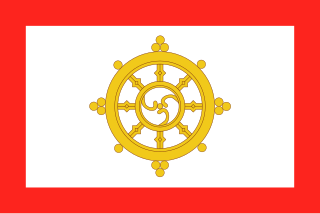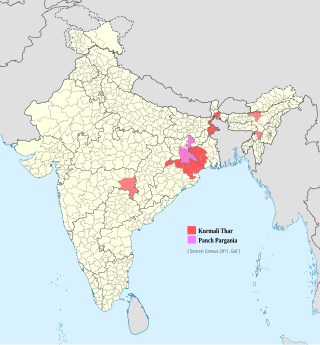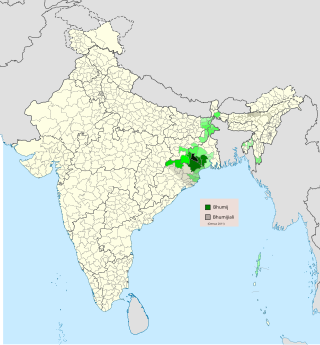Related Research Articles

A first language, native tongue, native language, mother tongue or L1 is the first language or dialect that a person has been exposed to from birth or within the critical period. In some countries, the term native language or mother tongue refers to the language or dialect of one's ethnic group rather than one's first language.

Bagheli or Baghelkhandi is a Central Indo-Aryan language spoken in the Baghelkhand region of central India.

Chandauli district is a district of Uttar Pradesh state of India, and Chandauli town is the district headquarters. Chandauli district is a part of Varanasi Division. Chandauli became a separate district for the first time on 20 May 1997.
Dumri block is a CD block that forms an administrative division in the Chainpur subdivisionS of Gumla district, in the Indian state of Jharkhand.

Korba District is an administrative district of Chhattisgarh state in central India. The headquarter of this district is Korba.
An indigenous language, or autochthonous language, is a language that is native to a region and spoken by indigenous peoples. This language is from a linguistically distinct community that originated in the area. Indigenous languages are not necessarily national languages but they can be; for example, Aymara is an official language of Bolivia. Also, national languages are not necessarily indigenous to the country.
War, also known as War-Jaintia, is an Austroasiatic language spoken by about 16,000 people in Bangladesh and 51,000 people in India. The language is spoken by the War Khasi tribe, i.e. War sub-tribe of Khasi people.
Yerukula is a Dravidian language mainly spoken by the Yerukala tribe. This language is also called Kurru basha or Kulavatha. Yerukala is linguistically close to South Dravidian languages such as Ravula and Irula. Lexical similarity among these languages ranges from 53% to 81%; in the case of Irula, it varies from 33% to 38%; in case of Ravula, it varies from 28% to 45%; in case of modern Tamil, it varies from 27% to 45%.

The Deori are one of the major indigenous communities of Assam. They historically lived in the area of Sadiya, Joidaam, Patkai foothills and in the upper plains or also called as the hinterland of the Brahmaputra Valley. Concrete documented records about the history of the tribe is very limited. Scanty information was found in few books and official records. The Deori language belongs to the Boro-Garo branch of the Tibeto-Burman language family. The community has maintained their racial traits, language, religion, folktales and traditional beliefs through the centuries. They were divided into Jimochayan/Dibang-Diyongial(Dibongia), Midoyan/Tengapania, Luitugan/Borgoya. The native language is retained only by the Dibongia group.

Sikkimese are people who inhabit the Indian state of Sikkim. The dominance ethnic diversity of Sikkim is represented by 'Lho-Mon-Tsong-Tsum' that identifies origin of three races since seventeenth century. The term 'Lho' refers to Bhutias (Lhopo) means south who migrated from Southern Tibet, the term 'Mon' refers to Lepchas (Rong) lived in lower Eastern Himalayas and the term 'Tsong' refers to Limbus, another tribe of Sikkim. “Sikkim is also known as the home of the Kirati tribesmen from the pre-historic times.Society in Sikkim is characterized by multiple ethnicity and possesses attributes of a plural society. The present population of Sikkim is composed of different races and ethnic groups, viz., the Lepchas, the Bhutias, the Nepalese and the Plainsmen, who came and settled in different phases of history. The community in Sikkim is inclusive of three sub-cultural sectors: the Kiratis, the Newaris and the Gorkhas.
Lambadi, Gor Boli, Banjara, Labanki or Banjari is a language spoken by the once nomadic Banjara people across India,Ancient Pastoral Nomadic Community of India Ancient Warrior Community/Raajputs Medieval Traders/Grain Carriers Modern Grain Transporters by Pack Bullock Cart Modern Semi-Nomadic Tribal Now Settlers.
Asuri is an Austroasiatic language spoken by the Asur people, part of the Munda branch. Asuri has many Dravidian loanwords due to contact with Kurukh.
The Kaikadi language is a Dravidian language related to Tamil, spoken by about 23,000 people of the formerly nomad Kaikadi tribe primarily in Maharashtra.

Kurmali or Kudmali is an Indo-Aryan language classified as belonging to the Bihari group of languages spoken in eastern India. As a trade dialect, it is also known as Panchpargania, for the "five parganas" of the region it covers in Jharkhand. Kurmali language is spoken by around 5.5 lakh people mainly in fringe regions of Jharkhand, Odisha and West Bengal, also a sizable population speak Kurmali in Assam tea valleys. Intellectuals claim that Kurmali may be the nearest form of language used in Charyapada. Kurmali is one of the demanded languages for enlisting in Eighth Schedule to the Constitution of India.
Kurumba, is a Southern Dravidian language of the Tamil–Kannada subgroup spoken by the Kurumba tribe. The Ethnologue classifies it as a separate language under Tamil-Kannada group.

Bhumij is an Austroasiatic language belonging to the Munda subfamily, related to Ho, Mundari, and Santali, primarily spoken by Bhumij peoples in the Indian states Jharkhand, Odisha and West Bengal. As per the 2011 census, only 27,506 people out of 9,11,349 Bhumij people spoke Bhumij as their mother tongue, as most Bhumijas have shifted to one of the regional dominant languages. Thus the language is considered an extremely endangered language.
The Patari are a community found mainly in the Sonbhadra district of Uttar Pradesh, India.
Bhatri is an Eastern Indo-Aryan language spoken by the Bhottada tribe in Chhattisgarh and Odisha, India. The language is spoken predominantly in eastern Bastar district and in Koraput and Nabarangpur districts of Odisha.

Bansjore block is a CD block that forms an administrative division in the Simdega subdivision of Simdega district, in the Indian state of Jharkhand.
Pakartar block is a CD block that forms an administrative division in the Simdega subdivision of Simdega district, in the Indian state of Jharkhand.
References
- ↑ Majhwar at Ethnologue (18th ed., 2015) (subscription required)
- ↑ Hammarström, Harald; Forke, Robert; Haspelmath, Martin; Bank, Sebastian, eds. (2020). "Majhwar". Glottolog 4.3.
- ↑ ST-15 Scheduled Tribe By Mother Tongue (For Each Tribe Separately) - 2011